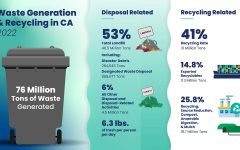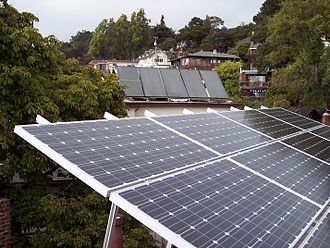
Rooftop solar. (Photo: www.energy.gov)
Ringside: The Disruptive Potential of Photovoltaics
There are many ways to generate abundant electricity
By Edward Ring, October 9, 2024 4:00 pm
 Earlier this year the New York Times published an opinion piece “What Will We Do With Our Free Power?,” written by David Wallace Wells. The sheer optimism of the piece was a breath of fresh air. Rather than emphasizing the existential terror of a climate crisis that renewable energy may help us avert, the author focused on the plummeting costs for photovoltaic electricity, with facts to back up his assertions.
Earlier this year the New York Times published an opinion piece “What Will We Do With Our Free Power?,” written by David Wallace Wells. The sheer optimism of the piece was a breath of fresh air. Rather than emphasizing the existential terror of a climate crisis that renewable energy may help us avert, the author focused on the plummeting costs for photovoltaic electricity, with facts to back up his assertions.
When evaluating California’s energy policy, the scale of the transformation the state has embarked upon could use a bit more optimism. Ratepayers who are exhausted by the current run-up in electricity prices compared to other states would be encouraged if they understood the path we’re on is likely, within just a few more years, to compel providers to compete on price to serve electricity in abundance.
To test this theory, consider the return on investment for a solar power producer even at today’s prices. The installed cost for utility scale photovoltaics is now down to under $1.50 per watt. This means that via a 25 year, 6 percent per year construction loan, the break-even cost for sold electricity is only $.05 per kilowatt-hour. That’s an annual average, but even in winter, break-even productivity sufficient to cover the construction loan payment would only be around $.08 per kilowatt-hour. At that rate, solar capacity can be profitably overbuilt to deliver energy even in winter.
Not only has the cost of photovoltaics come way down, but tremendous advances are being made in stationary batteries that use less expensive materials, as well as solid state batteries for mobile applications. With vehicle to grid technology and evolving pricing models, owners can opt to use their parked EVs to not only absorb surplus electricity from the grid, but also to sell electricity to the grid. This is not the least bit infeasible. If only 10 percent of California’s 14.3 million registered automobiles (that doesn’t include any commercial vehicles) were EVs with 50 kilowatt-hour batteries, they would have a total storage capacity of over 70 gigawatt-hours. California’s goal for total utility scale storage by 2045 is only 52 gigawatt-hours. A decentralized grid with hundreds of thousands of photovoltaic arrays and mobile storage assets can significantly reduce the cost and scope of transmission upgrades.
Critics of solar energy point to the land requirement. But a significant percentage of solar power can be generated in existing urban areas. There is an estimated 10 billion square feet of usable rooftop space (360 square miles) for photovoltaics in California, sufficient to generate around 275,000 gigawatt-hours per year if all of it were utilized. By comparison, California’s total electricity consumption in 2022, from all sources, was 287,220 gigawatt-hours.
California’s stated goal for renewable electricity production is 500,000 gigawatt-hours per year by 2045. To generate that much electricity with photovoltaics, while assuming the actual actual panels only occupy 50 percent of the allotted space in order to make room for access and other balance-of-plant assets (most utility scale solar farms don’t need that much extra space) would require approximately 1,300 square miles. To put that into perspective, California sprawls over 156,000 square miles; its entire urban footprint is about 7,800 square miles. The state has over 25,000 square miles of rangeland, suitable for cattle, but also suitable for solar panels. The state also has over 60,000 square miles of desert. If roughly 50 percent of California’s available rooftop capacity were covered with private, inside-the-meter photovoltaics, that would generate 150,000 gigawatt-hours per year. Generating the other 350,000 gigawatt-hours using utility scale solar fields would require another 900 square miles within an 85,000 square mile pool of land that’s either rangeland or desert. That should not be difficult. Even if California bets everything on PVs, farms and irreplaceable habitat are not at risk.
One way to evaluate the concern over area is to compare the space requirements of other renewables. As discussed in an earlier column, even if the BTUs in corn ethanol could be converted into electricity at 100 percent efficiency (with available technology, 40 percent is more likely), it would take 75,000 square miles of land to generate the 2045 goal of 500,000 gigawatt-hours per year in California. To do the same with land based wind power would require nearly 4,000 square miles. As noted, even if we didn’t put any of them on existing rooftops, doing this with photovoltaics would only require 1,300 square miles. There is room in sunny California for as much solar power as we’ll ever need.
Criticisms of renewables extend well beyond the space required, of course. We have to consider the raw materials, machinery, and energy required throughout the life cycle from initial manufacture to ultimate recycling. Unfortunately, most in-depth studies are so obsessed with reporting the CO2 footprint, they don’t offer easily retrievable data on anything else. Stay tuned. But it’s clear that biofuel requires prodigious inputs of water and fertilizer, along with stupefying quantities of space, for a relatively small return. Wind turbines require ongoing maintenance, along with incredibly wasteful quantities of concrete and steel to build their foundations and towers. Both onshore, and especially offshore, wind turbines also wreak environmental havoc.
To achieve California’s electricity generation goals, the real comparison is not solar vs wind and biofuel. Solar easily wins that contest. Rather we should evaluate to what extent photovoltaic power belongs in a common sense energy mix that includes ultra efficient combined cycle natural gas power plants along with nuclear power plants, augmented by sources with less scalability such as hydroelectric, geothermal, and various forms of waste-to-energy conversions. The ongoing and rapid decline in cost and required raw materials for photovoltaics and batteries, something that is not occurring with wind or biofuel energy, definitely positions photovoltaic power as increasingly competitive to conventional energy solutions. As always, the regulatory environment distorts costs and introduces a great deal of uncertainty into these comparisons. Nonetheless, continued investment in solar energy may provide that extra oomph that decisively lowers electricity prices in California.
If solar energy ultimately enables Californians to have access to abundant, affordable energy, it leads to tremendous positive ramifications. For example, a photovoltaic installation occupying less than ten square miles could generate enough electricity to desalinate one million acre feet of seawater per year. A photovoltaic array roughly half that size could treat a million acre feet per year of urban wastewater to potable standards. Abundant, affordable electricity can improve the cost-competitiveness of EVs, and make possible the revolution that has just begun in robotics and AI.
There are many ways to generate abundant electricity, and photovoltaics aren’t without drawbacks. But their potential to-date, if anything, may have been understated even by their proponents.
- Ringside: Will Advocates for More Water Supply Projects Find Unity? - December 11, 2025
- Ringside: EVs and California’s Future Demand for Electricity - December 4, 2025
- Ringside: Politically Viable Water Supply Projects - November 27, 2025





My son had solar panels installed a few years ago on his house in Sacramento – he was limited on how may panels he could have. I called, asked “Why the limit; I thought the goal these days is to produce as much solar power as possible.” I received explanations I really could not understand, so I gave up. Bottom line is we are told over and over to go solar – then when we try to, we are restricted…so back to fossil fuels I guess.
Solar produces power for a few daylight hours and then nothing. Using your car for night time power needs means you will probably find a dead car when it is time to drive to work in the morning. Electric cars are a thing of the past at least until batteries are twice as good, half the weight and one quarter of the cost. This is all probalby a moot point as battery car makers are going bust at a rapid pace. They sold for a while as some people believed the lies use to sell them. Reality has bitten them in the ass and good.
You also have to factor in a 100% redundancy rate with conventional power for nights, winters, etc.
Gas and diesel are the best choice for at least the next few decades.
It all seems so easy, we lay down some solar fields, generate some power and everyone is happy. No one ever addresses the additional infrastructure. Where do the transmission lines go, what deals need to be made with landowners whose property they cross, what environmental studies need to be done and at what cost, what upgrades need to be done to homes and business to support additional energy demands, will power lines in neighborhoods be able to support additional demand? I’m sure there are many other questions to be asked but it is not as simple as installing some panels in the desert and all of our problems are resolved.
This whole story is “pie in the sky” BS. Yeah, lets kill off all the cows and cover the range land with panels that will barely produce power for 20 years max before needing replacement, provided they survive the the storms of winter that long, so they can be dumped in a landfill because they are NOT recyclable. Good idea, stupid! How above just built a few nuclear power plants that will provide far more “clean” electricity for MANY more years on far LESS land! My god you “greenies” are imbeciles!
Now do photo-voltaic waste streams…
California recently reclassified PVs as Universal Waste, which is a joke.
The nearest recycler of PVs is in Yuma, Az because California has so many restrictions on the recycling process it’s a net negative game, with costs to ship higher than recoverable materials net worth.
Finally, as you have stated yourself here, we already generate so much PV electricity, a good percentage gets dumped to ground while peaker plants strain and heat cycle up and down to maintain the nighttime grid…
Yeah… lets add more PVs… or… how about we fix some of the use issues first.
Check out all the damage to PV systems in Florida. PV is especially venerable to weather damage. What the author calls ” a breath of fresh air” and “sheer optimism” I call pie in the sky lies that the left has used to promote various green scams for the last 40 years. Free power my Aunt Fanny!